Continuous Learning at Sasaki: Green Infrastructure Crawls
On a single day this autumn, employees from the Denver, New York City and Boston studios participated in citywide tours to learn about infrastructure design and stormwater management
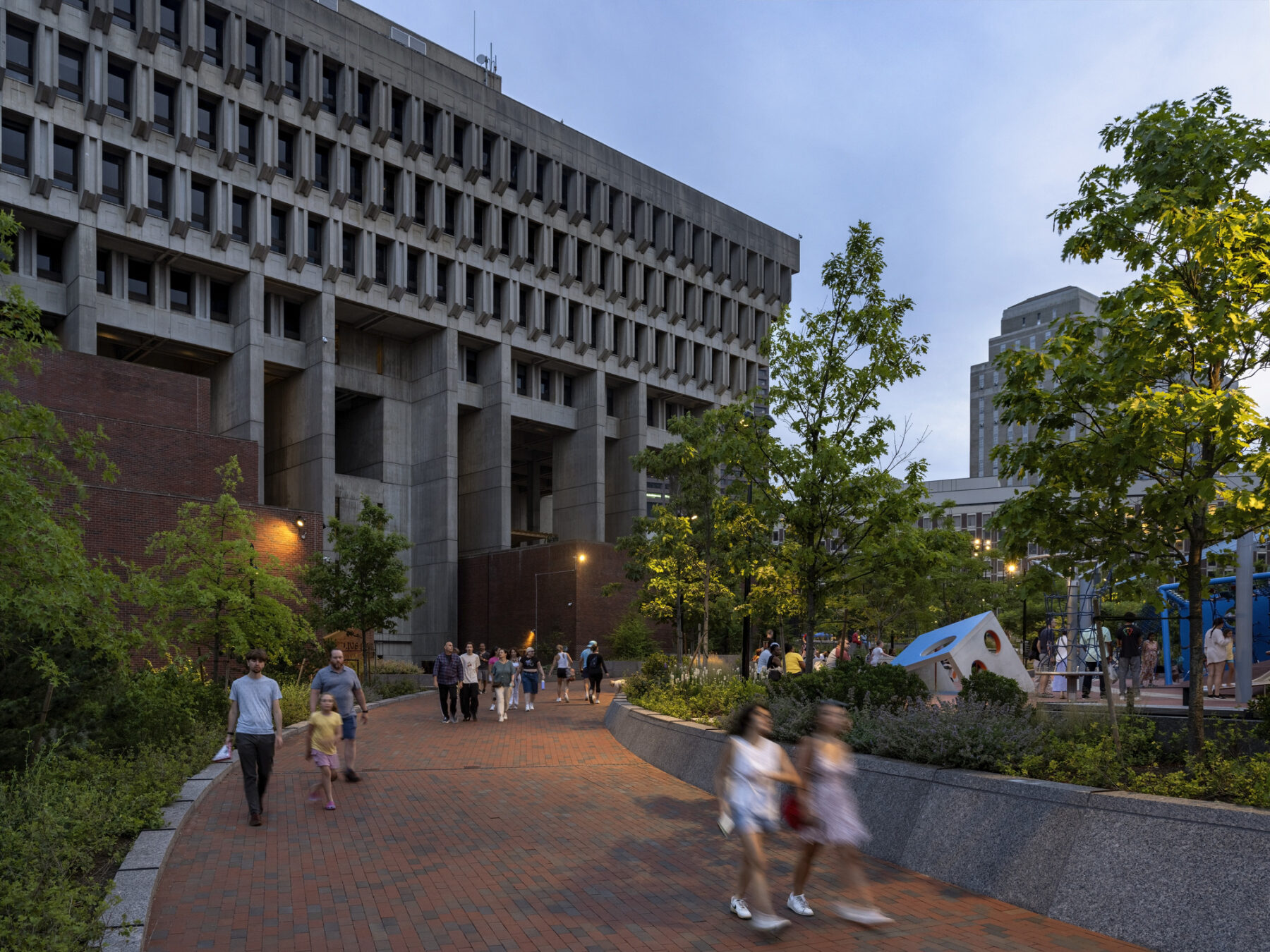
Boston City Hall Plaza is not only a notable civic space but also a case study for solving complex civil engineering challenges in a dense urban environment. Embedded in the plaza’s amenities are sometimes-obvious and sometimes-hidden sustainable practices that have transformed its performance. The plaza was recently recognized with an award from the Boston Society of Civil Engineers.
This piece was originally written for the Boston Society of Civil Engineers by Zach Chrisco, PE; Tulin Fuselier, PE, Geotechnical Practice Leader of Weston & Sampson; and Nathan Boutin, PE, Structural Engineer of Simpson Gumpertz & Heger. This is an edited version; see the article in its original format here.
Introduction
For five decades, Boston City Hall Plaza hosted the city’s largest gatherings from sports celebrations to political rallies to seasonal cultural festivals. But it lacked human scale, offered limited amenities, consisted of impermeable surfaces, and was highly inaccessible.
In partnership with city leadership and with the input of thousands of Bostonians, the renovated plaza is now a civic front yard where all are welcome. The improvements prioritize providing universal access, modeling sustainability and resilience, renewing the cultural legacy of this important Boston landmark, and providing flexibility for a variety of program types for years to come.
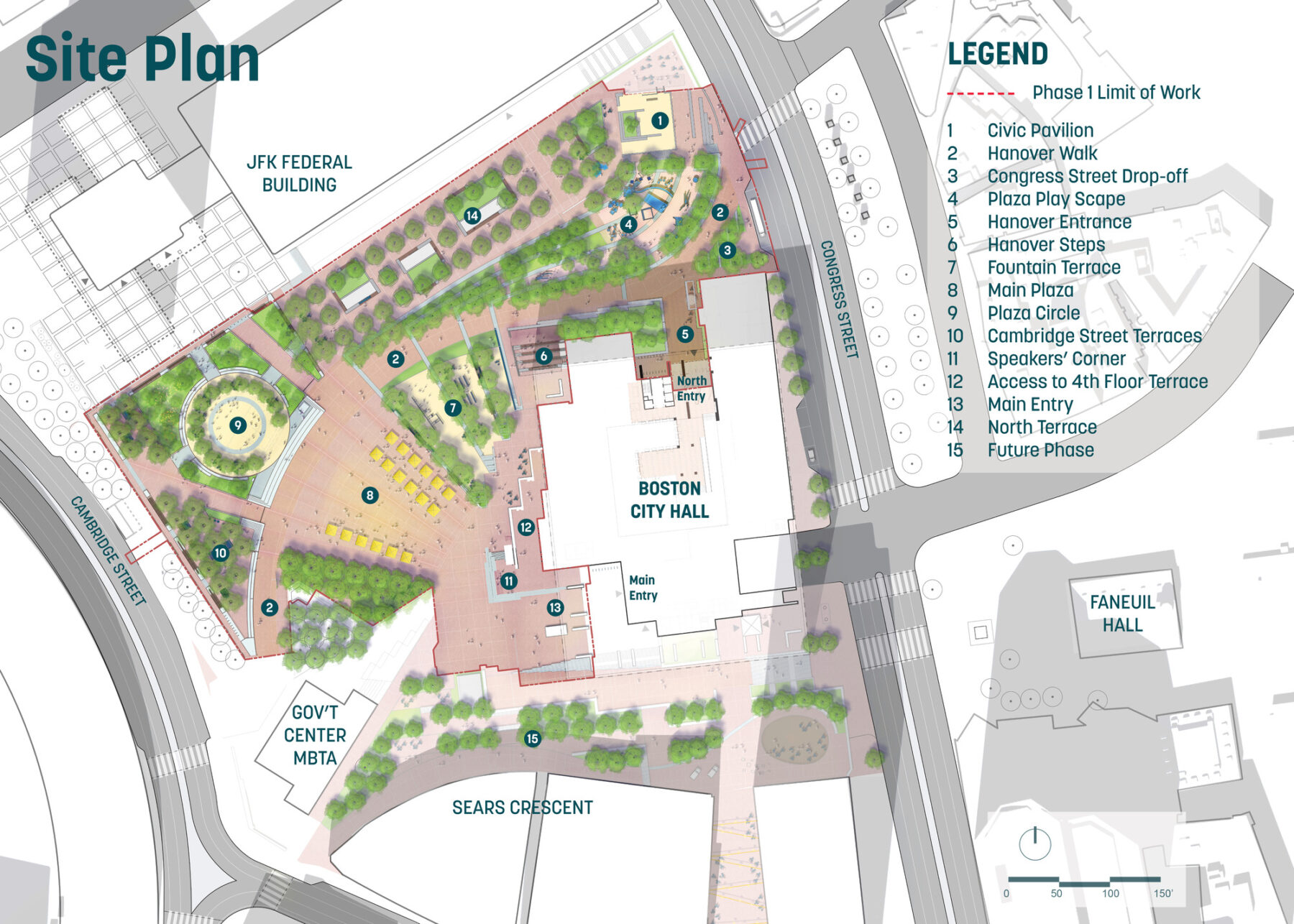
Components of the renewed plaza include a new ‘Hanover Walk’ that reconciles grade change across the site and connects Congress and Cambridge Streets with an accessible sloped promenade; a 12,000-square foot playscape that draws a new generation of users; new planting, seating and gathering areas breaking down the scale of the brutalist plaza; and a new Civic Pavilion nestled into the grade between Congress Street and the U.S. General Services Administration. Embedded in these amenities are sometimes-obvious and sometimes-hidden sustainable practices that have transformed the performance of the plaza.
Challenge: Impermeable surfaces that exacerbate downstream flooding, wash surface pollutants into Boston Harbor, and contribute to intense heat island effects
Approach: Green stormwater infrastructure
Working with the Public Facilities Department and Boston Water and Sewer Commission, the project prioritized the use of Green Infrastructure to manage rainwater and be a model for future Boston projects.
Over 60% of the surfaces provide porous conditions such as planting beds or permeable paving materials, which filter rainwater and restore the groundwater conditions. Approximately 35% of the rain is collected into a 10,000-gallon underground tank, which is then pumped back to the surface where it irrigates all the plants on site. The remainder of the rain that falls onto the plaza’s surface is treated through a treatment train system consisting of porous paving, a 95,000-gallon below-grade stone infiltration chamber, and subsurface water quality devices. It then flows into the city stormwater system, which drains into Boston Harbor. Environmental signage is included in the plaza, telling the story of the new green infrastructure as an educational opportunity for the thousands of plaza users.

The planting strategy includes over 250 new trees, 3,000 new shrubs, and 10,000 new perennials and grasses. Together they provide shade to over 50% of the site, minimize heat-island effects, sequestering more than 55,000 tons of carbon emissions, and creating a diverse plant-rich environment that supports urban ecological systems.
Challenge: Regrading an inaccessible plaza with a 26-foot grade change, which sits above the country’s oldest subway tunnels
Approach: Geoengineering for a resilient future
Revitalization of City Hall Plaza necessitated changes to existing grades, surfaces, and subsurface structures. The original plaza included multiple sets of steps to navigate a 15-foot grade change from north to south in addition to the 26-foot grade change from east to west, which made the site less accessible to the public and prevented access by emergency vehicles. Below the many steps, two of the country’s oldest subway tunnels, built in 1898 and 1902 and still in-use, traversed the site. For construction of the plaza in the 1960s, site grades above the tunnels had been raised by use of structural slabs supported on the tunnel walls, creating a void space between the surface and top of the tunnel. (See a time lapse of construction here.)
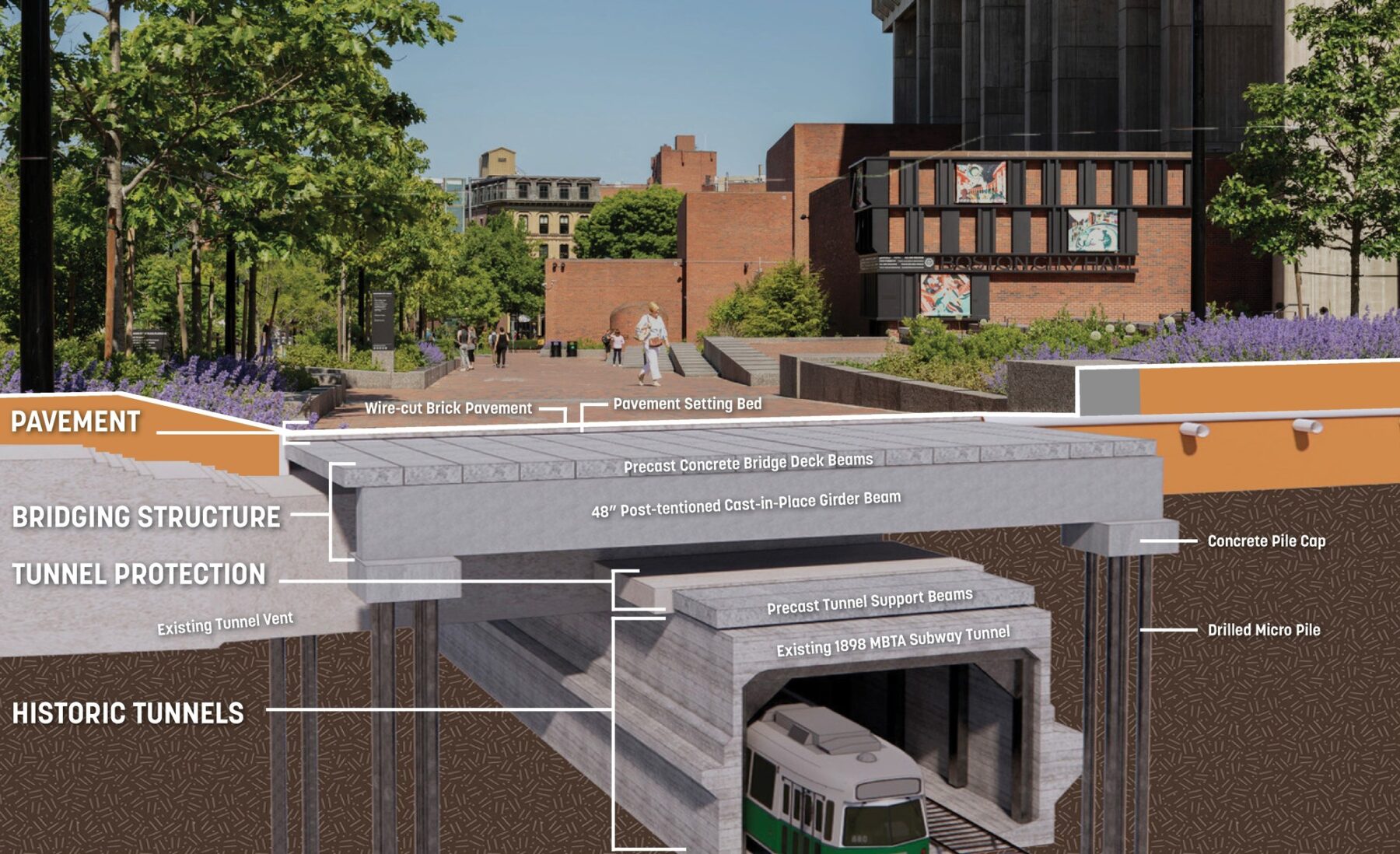
Proposed plaza conditions required that site grades be lowered in some areas and raised in other areas. It also required that emergency vehicles be able to access the plaza, potentially idling directly over the tunnels. The presence of the tunnels and compressible soils beneath presented unique design, construction, and logistical challenges that had to be carefully addressed and managed throughout the project.
To accommodate the proposed improvements, the void structures were removed and replaced with precast tunnel protection deck beams and then loaded with lightweight fill in the form of Foamed Glass Aggregate fill, a product of recycled glass, and limited areas of Geofoam, depending on proposed loads. In certain sections along the tunnels, where new loads from trees and green stormwater infrastructure did not allow for lightweight fill use, new structural slabs spanning over the tunnel and supported on tunnel walls were designed. This approach required up-front tunnel investigation, load-rating, analysis, and repair of some tunnel elements, but ultimately saved $6M in construction and more than six months in project duration. In limited areas, around tunnel vent structures with large tunnel roof spans, and where loads could not be accommodated on tunnel walls, structural slabs were supported on micropiles on each side of the tunnel.
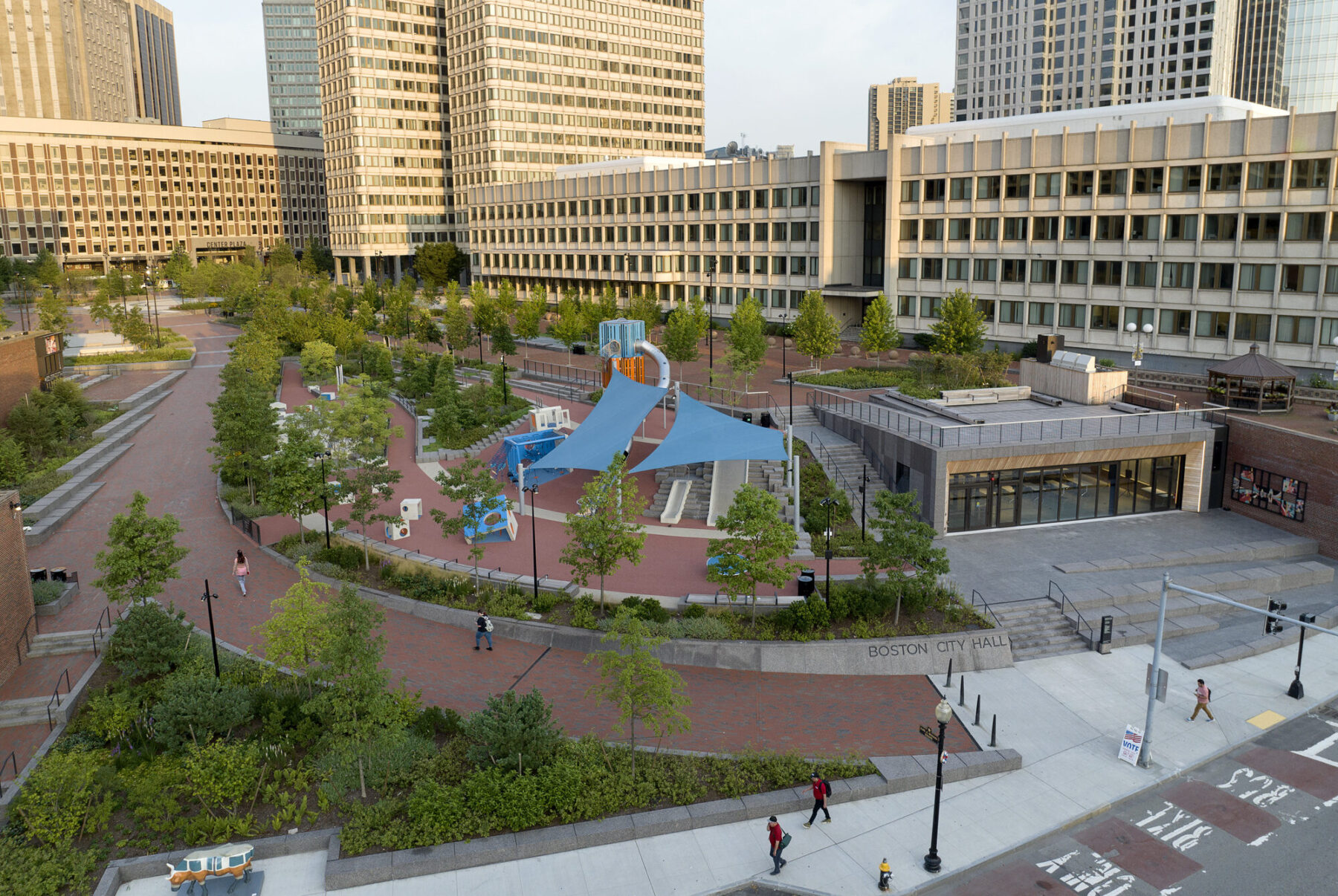
This system along and above the county’s oldest tunnels required the construction and design teams to work closely together; we planned and coordinated construction of each segment, as well as the movement of heavy construction equipment on and around the tunnels. The tunnels were instrumented to monitor movement on a continuous basis to ensure safe operation of the subway throughout the project.
Challenge: A civic pavilion and roof terrace that places no loads on the historic infrastructure beneath it
Approach: A cantilevered design, made of structural materials, placed in stages
The new civic pavilion activates Congress Street, housing restrooms, mechanical support for the plaza’s interactive water features, and ample room for diverse community programming–both inside and atop the building, on a roof terrace that opens onto the Cancer Garden of Hope. The 3,300-square foot venue features a glass wall that opens out towards Congress Street, inviting the public to explore the multi-use space that can host up to 150 people.
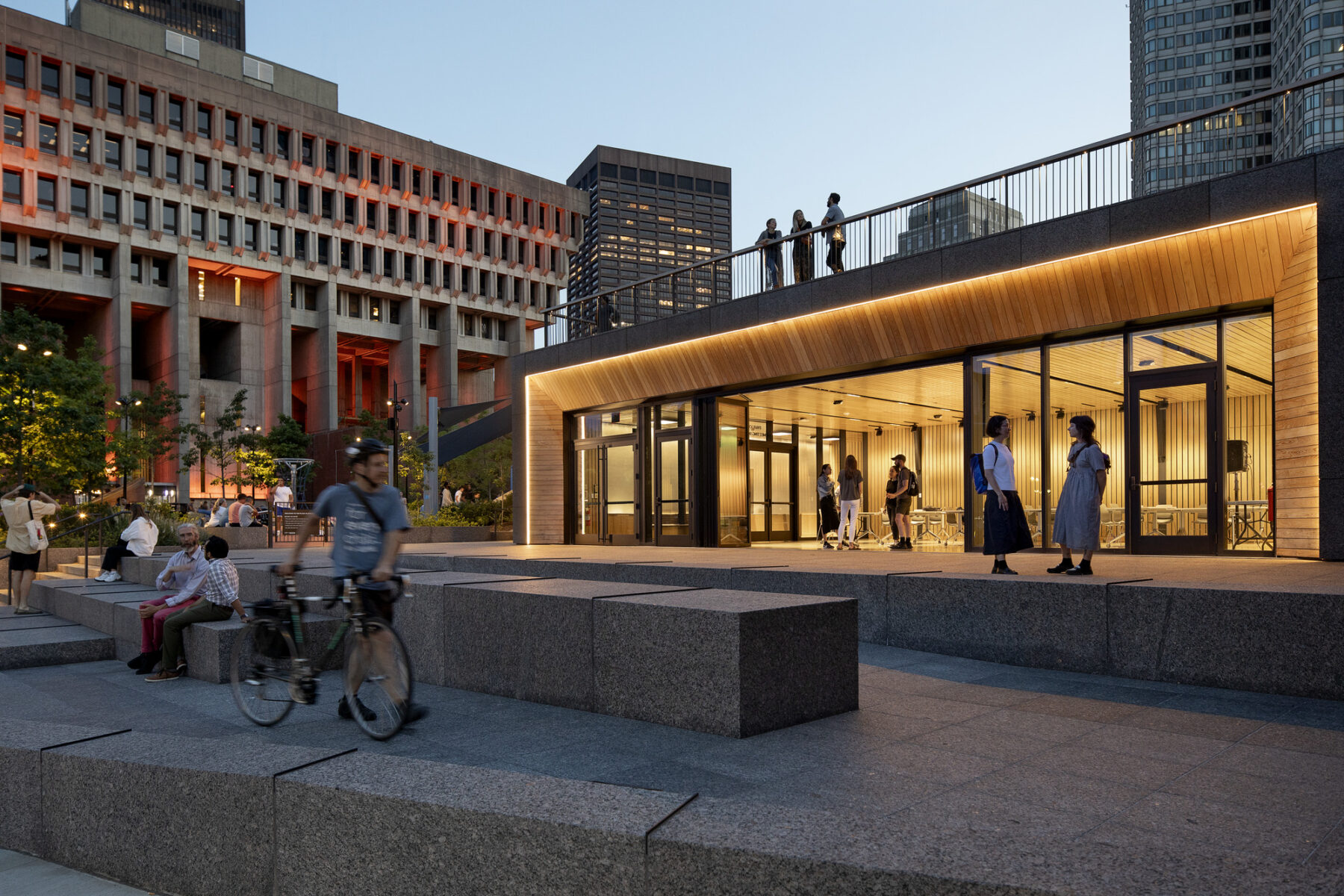
The pavilion structural framing uses two-story deep concrete girders that cantilever over the existing MBTA tunnel, as one project requirement was to avoid placing permanent loads on any portion of the tunnel. Due to the site constraints from the tunnel to the east and plaza-water-feature components to the west, the concrete girders have a long cantilever with a relatively short backspan. The girders are supported on deep foundations that were installed within the tight site constraints. This and the overall scale of the girders required deep-beam, strut-and-tie analysis to determine efficient reinforcement that would otherwise be controlled by more prescriptive design methodologies. The cantilever design also incorporated a two-stage placement method developed by the project team to limit heavy temporary construction loads on the tunnel roof. The initial placement was supported on the existing tunnel and only to the minimum height needed so that once adequate strength was achieved, that initial placement could act as a shoring beam for the upper second girder placement. Finally, the two placements act compositely to form the full-height permanent structure.
Large steel beams span between the cantilevered concrete girders that support interior space and the roof terrace above. The design team optimized loads for the cantilever geometry constraint, focusing on heavy loads from a roof garden in the backspan and placing lighter loads on the cantilever with minimal-depth surface paving. The east steel beams at the outer tip of the cantilevered concrete girders were designed for extremely tight deflection criteria. A glass folding partition wall along the east elevation required tight structure deflections to maintain operation and avoid damage, and the level transition between the east end of the building and the adjacent on-grade finishes needed tight deflection tolerances for expansion joint detailing.
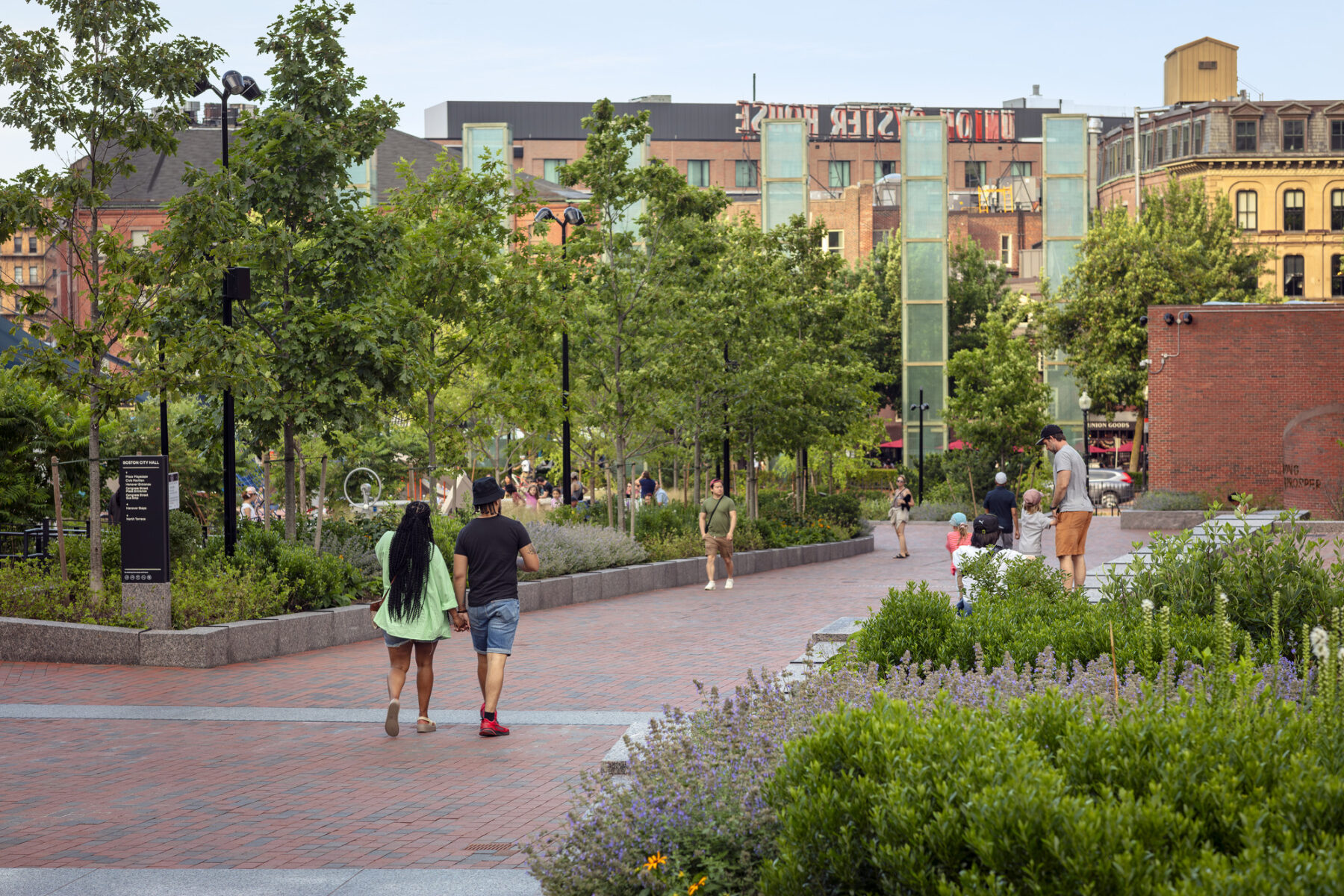
On a single day this autumn, employees from the Denver, New York City and Boston studios participated in citywide tours to learn about infrastructure design and stormwater management
Generating innovative approaches to stormwater management on campuses, helping to position institutions as stewards of their watersheds
Here at Sasaki, the word “interdisciplinary” is a part of our everyday vocabulary